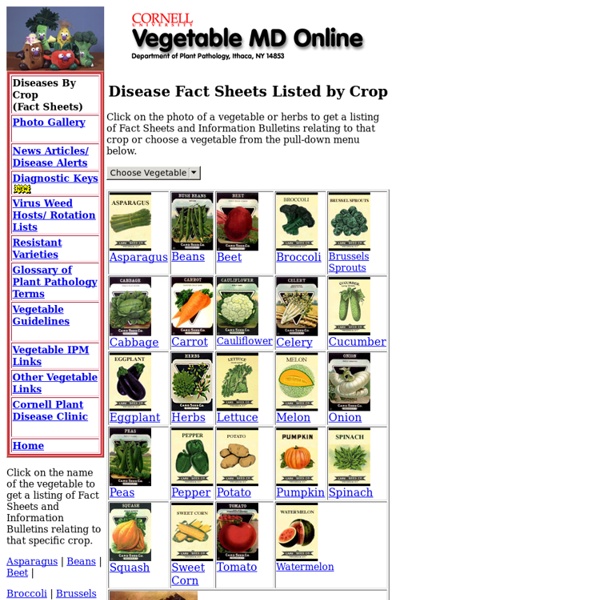



http://vegetablemdonline.ppath.cornell.edu/cropindex.htm
Related: GarraíLate blight on potatoes More late blight information Large leaf spots (lesions) are common with late blight. These were the main symptom seen in a commercial field on LI in 2009 when this disease was first found. The most profitable plants in your vegetable garden 5.3 years ago cheap, cilantro, garlic bulbs, organic, seedling, seeds, vertical gardening, winter garden Many vegetables can be expensive to purchase by growing the most expensive vegetables in your garden and buying the least inexpensive vegetables at your grocery store you can easily help drop your food budget. This especially important for people like me with very limited space to grow everything that I consume.
Detection of Potato Tuber Diseases & Defects fact sheet Introduction Good disease management is critical to the successful production of the white potato (Solanum tuberosum L.). The potato plant is susceptible to at least 75 diseases and nonparasitic disorders, many of which consistently cause yield losses in potato production areas in the northeastern United States. Potatoes are a vegetatively propagated crop, and potato seed tubers can be an important source of disease inoculum. Several types of injury that can influence plant vigor and subsequent yields also occur on seed tubers. How to plant a living wall Amelia B. Lima's lush and verdant wall of plants. Jennifer Cheung
Bloomingfields Farm Garlic - - How To Make a Garlic Braid (illustrated) - - Tools Materials Preparation Braiding Finishing T o o l s — scissors, old toothbrush, 2 medium-sized bath towels, pocket knife M a t e r i a l s — 13 dried and cured, softneck garlic bulbs with long leaves, Jute twine 36 in. long ( Note: there is no true plant stem in softneck braiding garlic, but for our purposes here we will refer to the lower third of the top as a ‘stem’ ).
DIY Vertical Herb Garden with a Shoe Organizer by LiveOAK Staff on July 20, 2009 Confounded by vegetable digging cats and toiling in the vegetable patch, Instructables member pippa5 came up with this cool DIY vertical garden solution. In case you don't recognize it, she used an old closet shoe organizer. Meant to keep your shoes off the floor and save you some space, this new use saves some space by getting your veggies or herbs off the ground. The Garlic Farm - for all things garlic Hardnecks Produce a hard flowering spike. Cloves form around a central stem. Varietiesinclude: Purlpe Moldovan, Lautrec Wight, Chesnok Wight, Red Czech & Red Duke Wight (new).
Gardening with Guineas by Jeannette S. Ferguson from the June/July, 2008 issue of Backyard Poultry Moving to a home with some land in the country has its advantages. It is quieter, peaceful, no fumes from cars, buses or trucks, no smog, fewer neighbors, fresh air, room to run, freedom to play loud music, room to have big parties with plenty of parking space, more than a few pets/animals, plenty of room to grow corn or huge veggie gardens, and most of all—room for thousands of flower specimens and numerous gigantic flower gardens. I was able to fulfill a dream and had the room to construct a hobby greenhouse. The greenhouse made it possible for me to grow the unusual plants I could not purchase locally and gave me a very pleasant way to enjoy fine gardening in the great outdoors during the coldest months of winter. Gardening under glass in the winter made flower gardening year-around a fascinating, wonderful hobby for me. Shortly after moving here, well over 20 years ago, I joined the local village garden club.
Making Comfrey Compost, Comfrey Liquid Feed or Tea Comfrey as a Compost Activator Cuts of comfrey fresh or wilted can be laid onto the compost here, layered with the weeds or grass cuttings. Comfrey is so rich that it can be used as if it was manure to activate a slow compost heap. A layer of wilted comfrey can be laid in the trench before planting potatoes. 15 houseplants for improving indoor air quality - Gerber Daisy Interested in uplifting stories on the natural world, sustainable communities, simple food, and new thinking on how to live well? Please enter a valid email address and try again! No thanks Féilire: When to plant vegetables Gardening Advice Center Share with us your gardening experience! Name: jim@GardenAction E-mail: webmaster@gardenaction.co.uk Date posted: November 23, 2011 - 04:05 pm Message: Read the pages on this website and follow the advice, join a garden club or allotment society, happy gardening. Name: spencer E-mail: spencerleelazone@yahoo.co.uk Date posted: November 23, 2011 - 08:44 am Message: Fist timer,in veg growing..have you got any tips or advice..want to grow nice variety..thanks
Plants for Pathways These are the most forgiving Woolly thyme likes to stretch its flat branches out over sidewalks and stairs. It is useful in softening the lines described by hardscaping materials like brick and concrete. Ornamental thymes (Thymus spp. and cvs.) are probably one of the most forgiving groups of plants when it comes to foot traffic. Woolly thyme (T. pseudolanuginosus, USDA Hardiness Zones 5–9), a 1-inch to 3-inch-tall ground cover, is good for use in a walkway since it grows flat. Its minute gray leaves really are woolly, or pubescent, and give the plant an all-over soft and fuzzy appearance. Making Compost Teas. See How to make Liquid Soluble Fertilizer from Manure, Comfrey and more. How to make compost tea and other soluble, liquid fertilizers from manure, comfrey, nettles and other herbs and weeds. There's nothing like a pick-me-up... a nice cuppa that is. How about making compost tea to perk up your plants. Many people simply wither without their regular cup of tea or coffee.